Viking Apron Dress and Assesores
There are small scraps of material found in graves, usually with small remnants of wool. Wool holds up better than linen. Very often these preserved scraps were found with metal jewelry like turtle brooches. The salt in the metal acts like a preservative. No complete dress is found.
The underdress or a serek or shift is basic. I chose to make mine ankle length as seen in the tapestry from Oseburg. I used unbleached linen for my serek. I had to add a strip of gold linen to the bottom because I did not have enough fabric, very period! I used linen thread with the running stitch. I turned the edges under with the whip stitch to keep the linen from fraying. I used the Herringbone stitch in green wool thread to strengthen the seams. Not much embroidery is found on Viking garments. But I did want this dress to be for a woman of high station so I embroidered the neckline and cuffs with the acanthus vine pattern found in a Mammen grave site in green wool thread. I used a stem stitch.
The Apron dress is also called a smokkr or hangerok. I had some blue linen already. Blue is a color they would have produced using woad. I used a running stitch, turned the edges under with a whip stitch. I made some lucet cord of gold wool and attached it to the seams to strengthen and decorate them. https://halldorviking.wordpress.com/2012/11/04/lucets-and-lucetting/ I added tablet weaving made on an inkle loom. It is a simple Oseberg pattern. I used this site and pattern. http://ladyelewys.carpevinumpdx.com/2020/04/26/oseberg/n
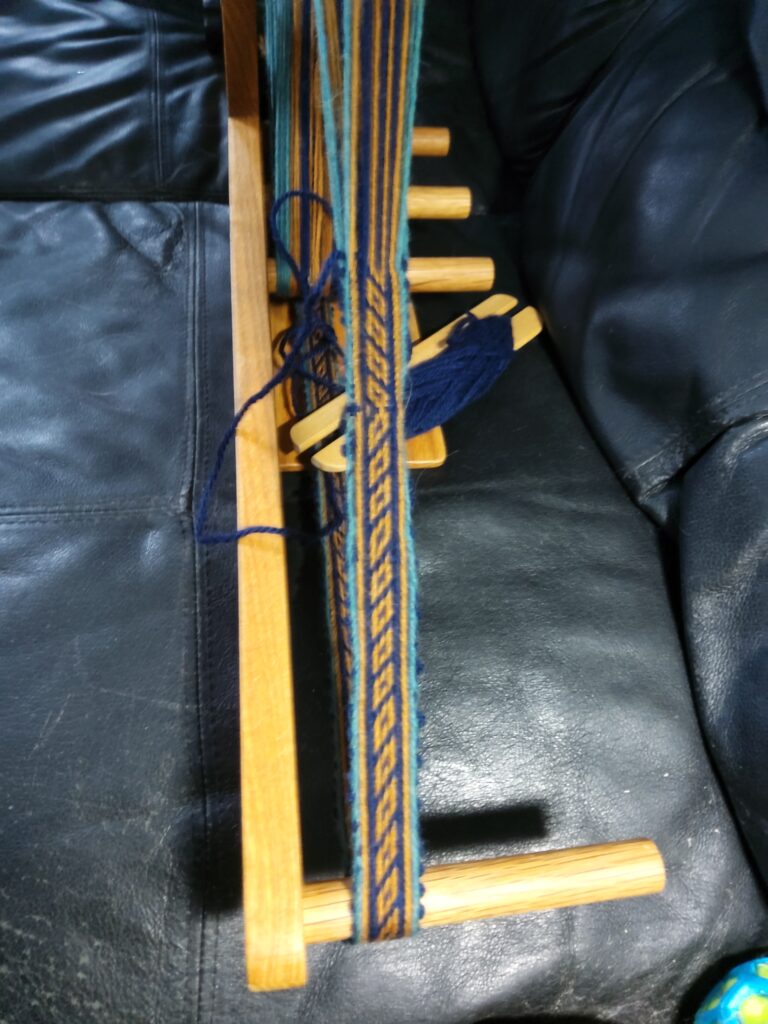
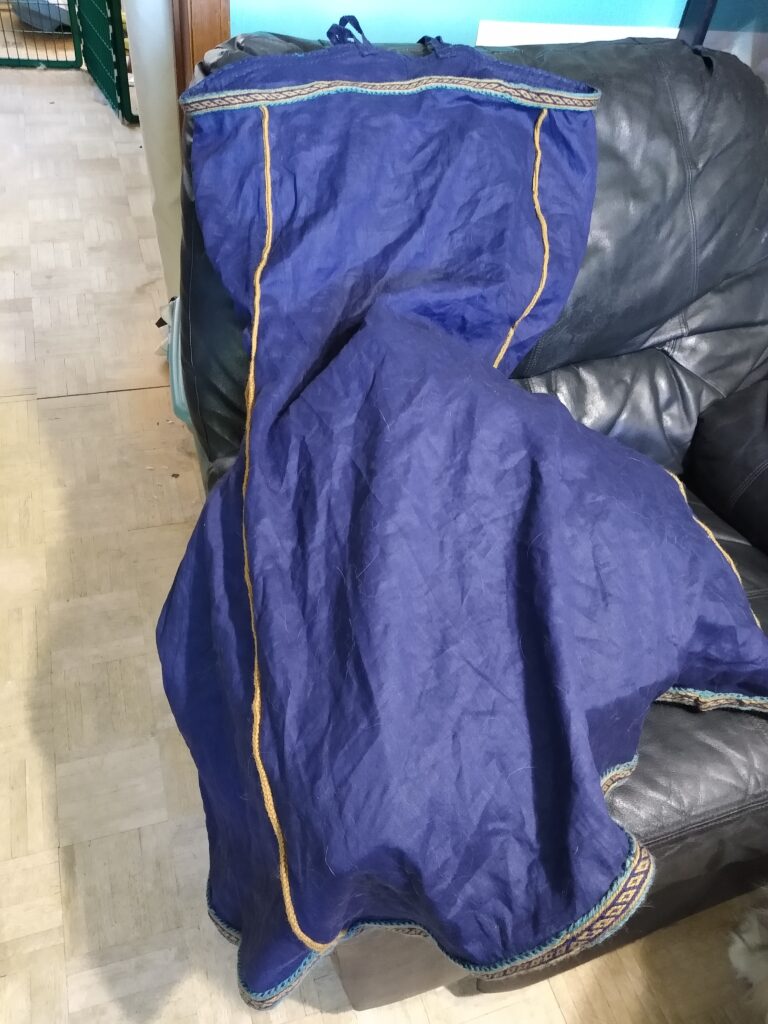
Panel
Loops of fabric are found on the inside of the oval brooches in graves at Viking archeological sites. These could possibly be a panel or decorative piece. I made my panel out of green wool. I used the horse from the Oseberg Tapestry as inspiration. I also added decorative bands.
http://www.germanicmythology.com/works/OsebergTapestry.html
I used the stem stitch an red wool thread for the border, and green wool thread for the horse. I plan to fill the horse in stem stitch. I am also going to add blue wool lucet cord to the border.

Socks
The Vikings did not knit. They used a bone or wood needle and a length of yarn to join a series of loops together. It took me quite a bit of time to teach myself nalbinding. The first sock was just ok but when I split the heel and went back and added the heel after it fit much better.
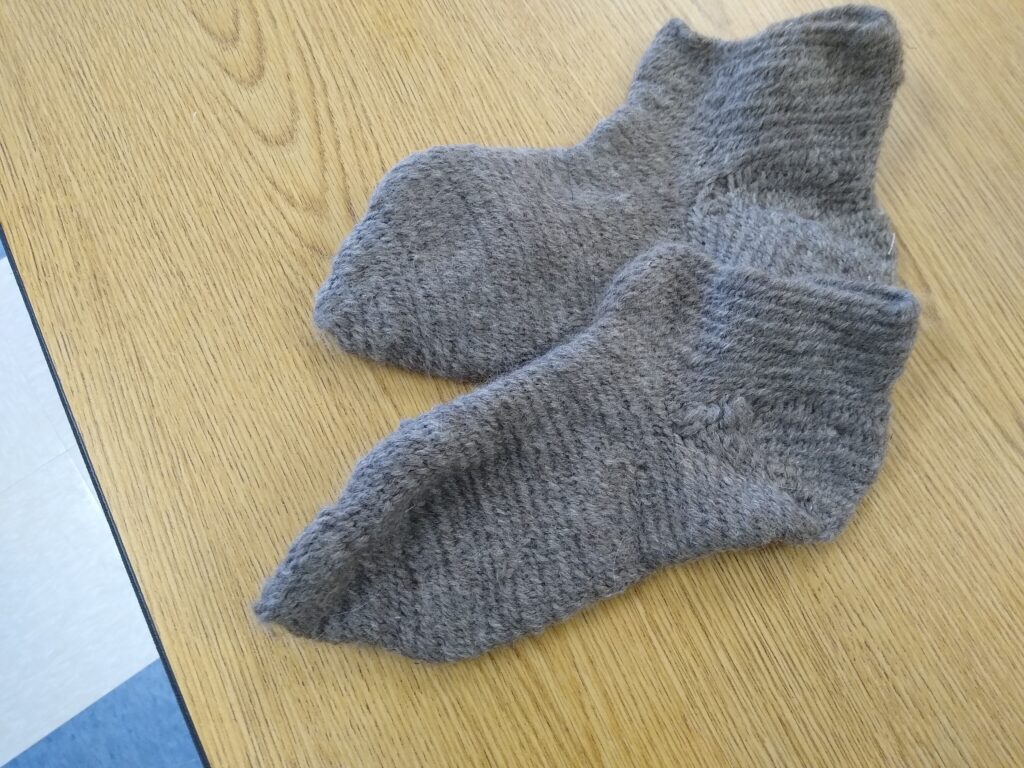
Shawl
The women in the Oseberg Tapestry look as if they are wrapped in a shawl. It is a very practical and good item to have on a cold night. I made a wool shawl in black and grey, both natural colors. I wove my shawl in plain weave on my large rigid heddle. This is my first project on the heddle loom. My first try I made the shawl too small and I beat the shuttle to hard. The second is good, I like the way it goes around me comfortably and looks like this picture on the right of a textile sample. This photo is from Nile Glaesel’s book Viking.

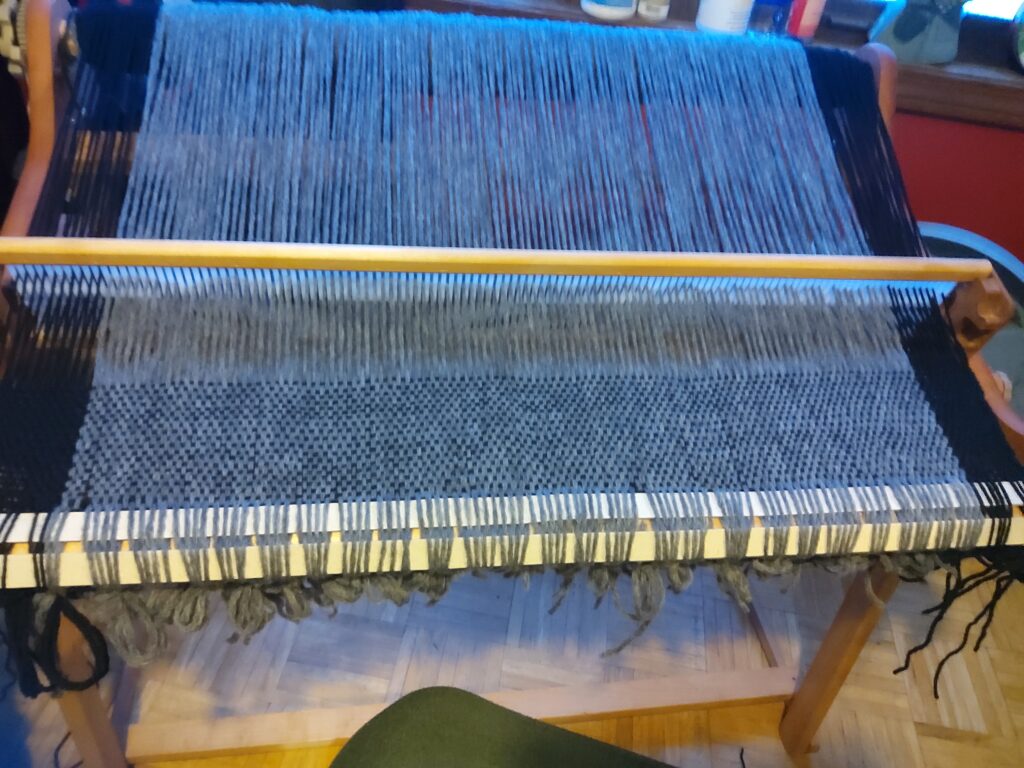
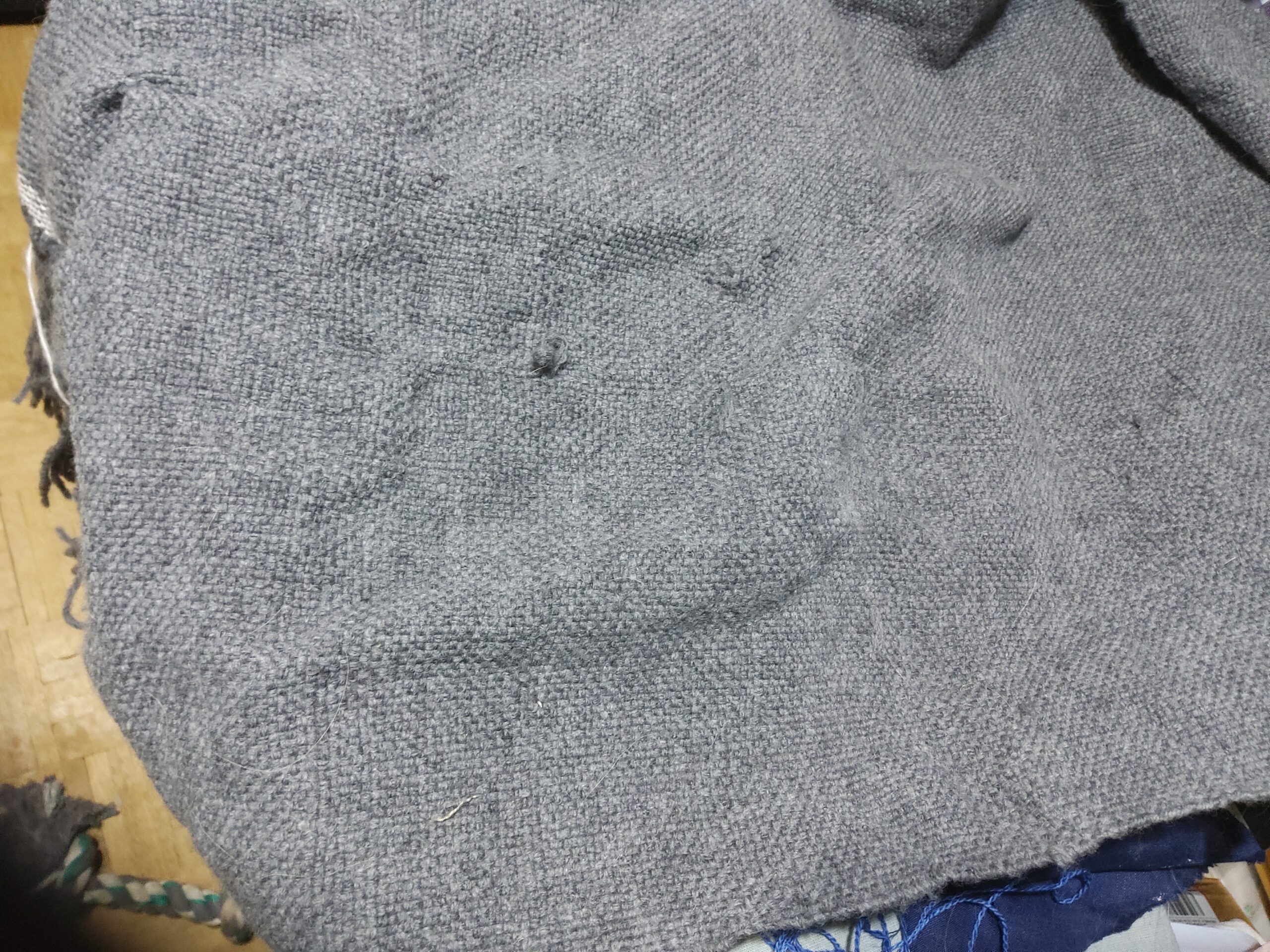
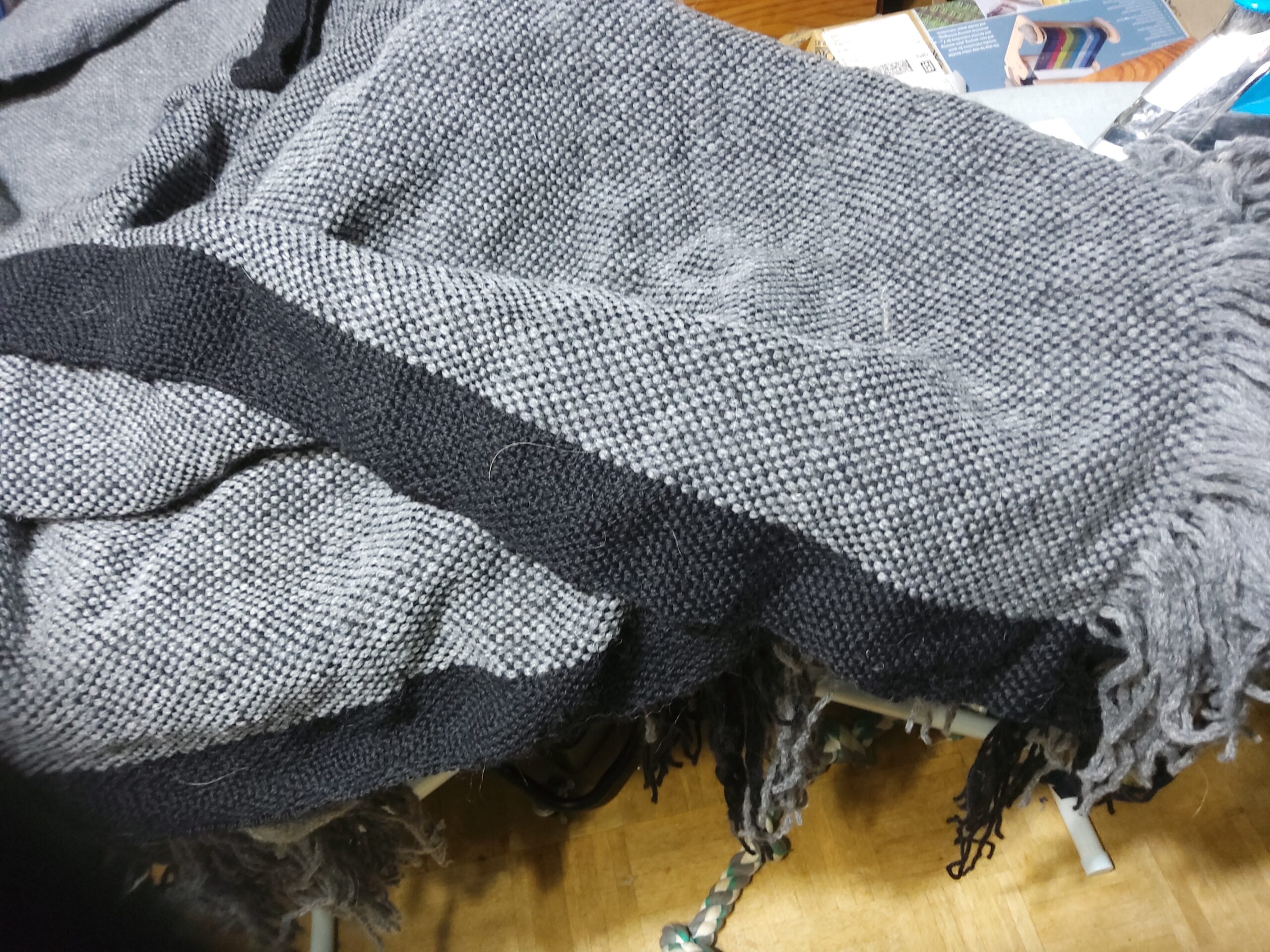
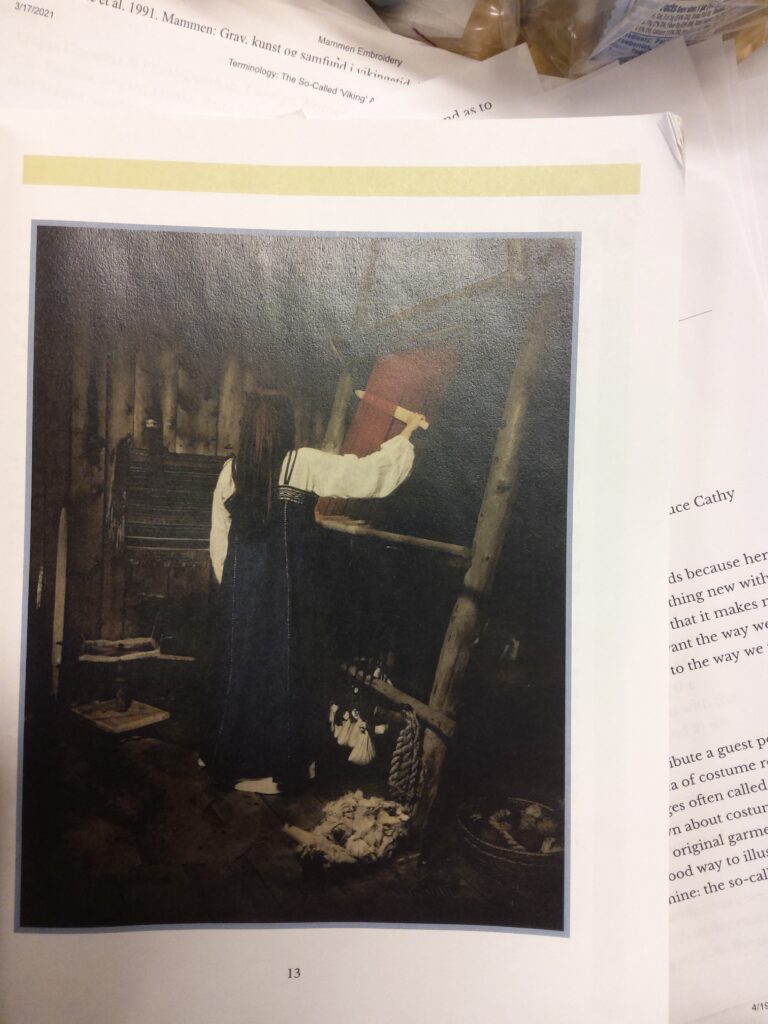
Because I can no longer stand for long periods of time or have space for this type of loom, I used a rigid heddle. The Vikings used a weighted loom to weave all their cloth. The weights on the bottom kept the warp tight. It had a boom at the top to roll the fabric on. My rigid heddle has two booms that keep the warp tight between them. Also the rigid heddle has a reed comb that creates the heddle unlike the weighted loom. The Vikings used a beater made of hard wood, iron, or even whale bone. The weights were clay or stone. They had different weaving patterns and I would like to study and try different weaves from this period and actually weave cloth for a dress, maybe after the Hedeby find.
Jorvik Hood
3 Jorvik hoods made of silk with maybe linen ties were found in York or Jorvik and are described in ‘ Textiles, Cordage and Raw Fibre from 16-22 Coppergate’ by Penelope Walton (Council for British Archaeology. London, England 1989). The original is displayed at the York Archaeological Trust (YORM 1980.7.8129). I made my Jorvik hood out of white linen. The first one I made I used the recommended 8×24 inches and it would not stay on my head. I am probably a lot taller and bigger than our ancestors. So I measured my head to where I wanted my cap to be. This attempt came out much better an just looks and feels right. I do want to make my next one out of silk. I left this cap plain, no embroidery so I would not overdo the embroidery.
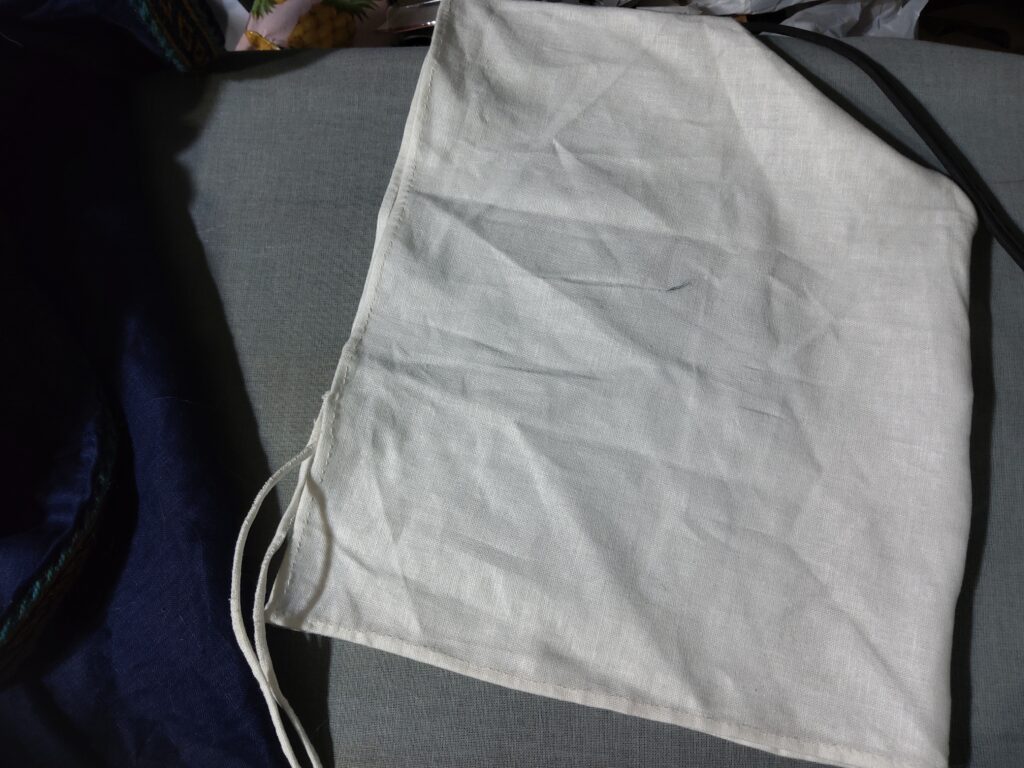
Skjoldehamn hood
A body was discovered in a bog in 1936 near Skjoldehamn on the Norwegian island of Andoya. The costume was intact and included a hood. Now this figure was male, and I found no evidence that women wore this type of hood. I might just have missed it, but I have seen many SCA women wearing this type of clothing. I wanted to include this hood in my garb because it is practical and warm on cold nights. The outside is blue wool and the lining is green. I don’t believe the original artifact had a lining. I made mine with 3 squares. I used a running stitch and whip stitch. I am embroidering the Tree and Paired Beasts motif from a burial at Bjerringhoj, in Mammen parish, in northern Denmark. It is dated 10th century. I also used the colors in the reconstruction from the museum. I used only the stem stitch to outline my embroidery. I will fill the inside with stem stitch.
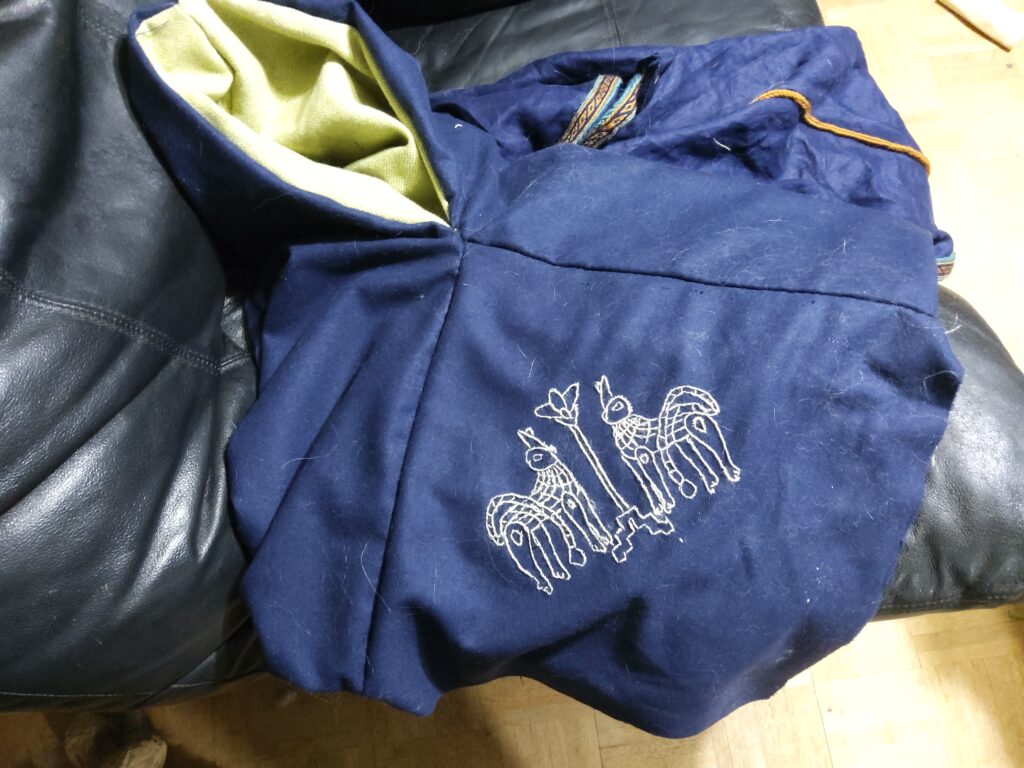
Belt
I wove with my tablet cards on an inkle loom, a belt in cotton yarn. I did not have linen yarn at the time and I could not do it like I did with wool yarn and the Oseberg pattern earlier. I found that the number of cards, bulkiness of yarn, and the sticky nature of wool made it impossible for my skill level. I used white, green and blue for color. I wanted sharp contrast to show the design off to the best advantage. http://ladyelewys.carpevinumpdx.com/tag/birka-22/ The Original band was excavated on the Bjorko island in Sweden. It has been marked as 1C area of the cemetery in grave no 824 and is dated to be approximately 9th to 10th century.

Mittens
I wanted to nailbind a pair of mittens but did not have enough time for this challenge but I will when I can. So I made a pair of cloth mittens in wool. I found 3 finds of Icelandic mittens made from woven cloth, wool, this one is from the landnam period about 874-930CE.

I added some fur trim. If there was trim on this mitten, it has disintegrated along with the hem and selvedge. It also had a wool lining.

Birka Wallet
This item is a folded wallet with compartments on the inside. They were decorated with gold plated leather, woven to form a checkerboard design. Along the edges were gold plated loops. This artifact has only been found in Birka, Sweden. I am using a pattern and tutorial from Dark Horse Workshop. It is his interpretation of the Birka wallet. This will be my first attempt working with leather. I start this project tomorrow.
Haithabu Bag
Handles made of carved wood was found in Hedeby and Birka. At the site in Hedeby 2 handles were found that were identical. No fabric or leather remained. It is speculated that a pair was used to make a bag much like the example of a Sami leather bag with antler handles. http://dawndressdiary.worfdpress.com/2019/03/04/hedeby-hithabu-bag-handles-
I found these handles on the internet.
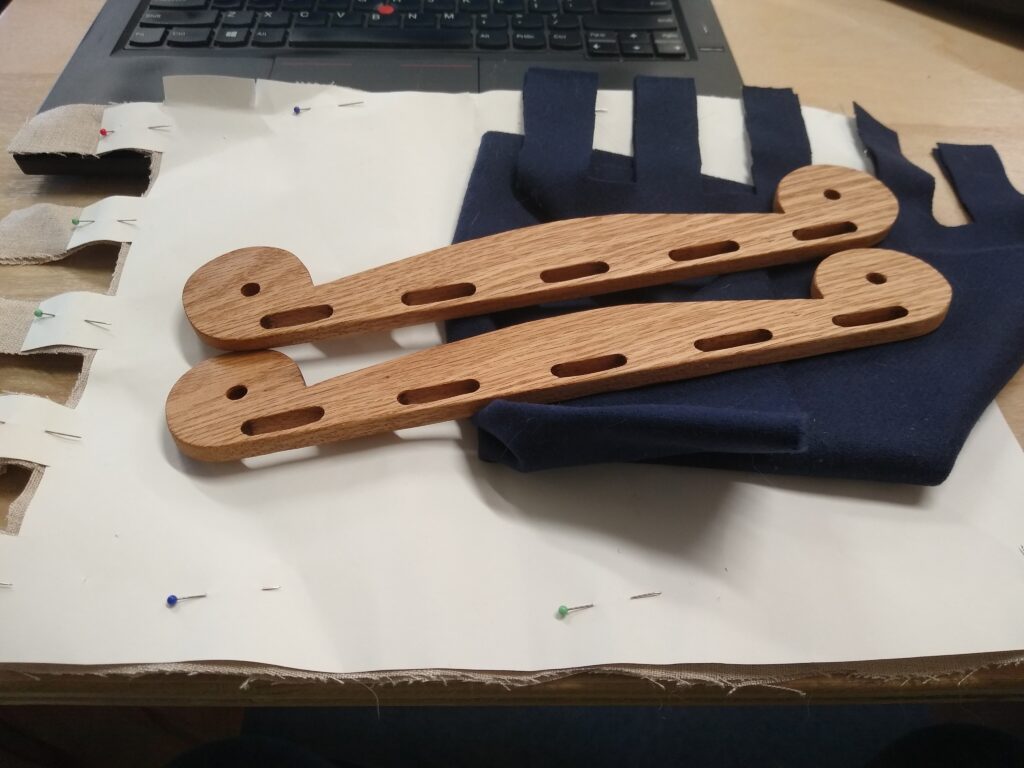
I am using a beast in a roundel for the embroidery on my bag. The source was found in an Oseberg ship burial and is thought to be Saxon in origin.
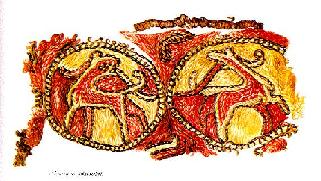
These are my drawings.

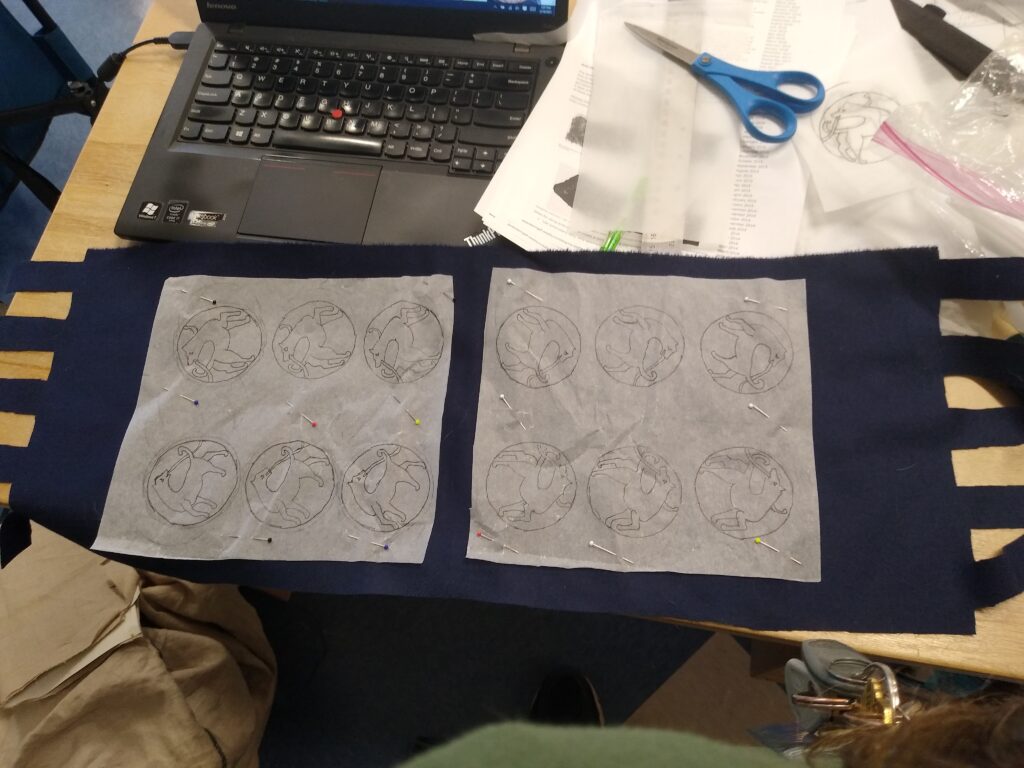
I will use wool thread. I will use colors as close to the original as seen above. I am using stem stitch and I will couch white wool for the roundel. That will look closest to what I see in the original.
I have linen yarn and will weave the cord on my lucet. I will with time also weave a tablet trim with linen yarn for the top of the bag.
More Sources
Viking dress, garment, clothing by Nille Glaesel
The Ashford Book of Rigid Heddle Weaving by Rowena Hart
Lots of Socks by Larry Schnitt
Nailbinding by Nusse Mellgren
Dark Horse Workshop Birka Wallet youtube.com/darkhorseworkshop
www.darkhorseworksop.com
http://valkrija.com/needlebinding
awanderingelf.weebly.com/blog-my-journey-category/viking-textiles-looking-deeper592902ffb1
https://bjornthisway.wordpress.com for period stitches.
www.vikingage.org/wiki/wiki/Bags%26Pouches
http://dawbdressdiary.wordpress.com/2019/03/04/hedeby-hithabu-bag-handles/

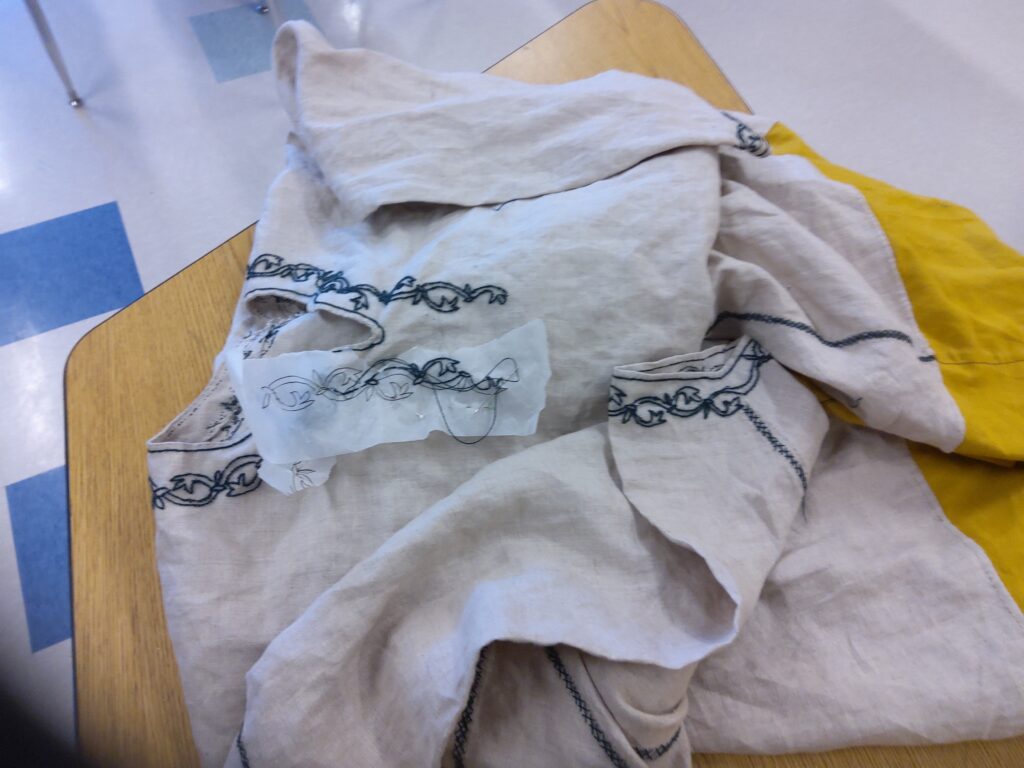

Link to the bag handles blog is: https://dawnsdressdiary.wordpress.com/2019/03/04/hedeby-haithabu-bag-handles/